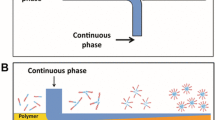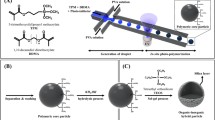Abstract
We present geometrically passive T-junction breakup as a high-throughput preparation method for polymer microcarriers. In passive T-junction breakup, an alternative method that can satisfy requirements for uniform size distribution and high production, a polymer solution droplet is split into numerous smaller droplets as it passes T-junctions, and is then polymerized into particles as solvents evaporate. Microparticles generated from poly(lactic-co-glycolic acid) (PLGA) were used to demonstrate the applicability of this method. The proposed method of droplet fission, controlled by microfluidic flow, allowed for preparation of biopolymer particles at 8000 Hz and size distribution of CV < 5%. Feasibility of the prepared PLGA microparticles was verified as microcarriers for functional materials: lidocaine, carbon nanotubes (CNTs), and 3T3 cells. The prepared microparticles showed a slower and more linear drug release profile compared to those generated using the conventional evaporation method. Highly porous microparticles were also prepared successfully using gelatin as a porogen in the T-junction breakup device.
Similar content being viewed by others
Abbreviations
- Q d :
-
dispersed phase flow rate
- Q c :
-
continuous phase flow rate
References
Freitas, S., Merkle, H. P., and Gander, B., “Microencapsulation by Solvent Extraction/Evaporation: Reviewing the State of the Art of Microsphere Preparation Process Technology,” Journal of Controlled Release, Vol. 102, No. 2, pp. 313–332, 2005.
Noor, S. H. M., Yaacob, I. I., and Ang, B. C., “Polymer Matrix Templated Synthesis: Manganese Zinc Ferrite Nanoparticles Preparation,” Int. J. Precis. Eng. Manuf., Vol. 14, No. 4, pp. 671–673, 2013.
Bao, P. Q. and Ko, S. L., “Characterization and Recognition of Particles for Improving Cleanability in Automotive Production,” Int. J. Precis. Eng. Manuf., Vol. 14, No. 6, pp. 977–984, 2013.
Lee, J., Yoon, Y.-J., Eaton, J. K., Goodson, K. E., and Bai, S. J., “Analysis of Oxide (Al2O3, CuO, and ZnO) and Cnt Nanoparticles Disaggregation Effect on the Thermal Conductivity and the Viscosity of Nanofluids,” Int. J. Precis. Eng. Manuf., Vol. 15, No. 4, pp. 703–710, 2014.
Siddique, A. H., Cho, S. H., Ahn, B., and Kim, C., “Ultrasonic Manipulation of Magnetic Particles in a Microfluidic Channel,” Int. J. Precis. Eng. Manuf., Vol. 15, No. 7, pp. 1411–1416, 2014.
Jain, R. A., “The Manufacturing Techniques of Various Drug Loaded Biodegradable Poly (Lactide-Co-Glycolide)(PLGA) Devices,” Biomaterials, Vol. 21, No. 23, pp. 2475–2490, 2000.
Kim, H.-G., Kim, K.-M., Kim, Y. H., Lee, S. H., and Kim, G. M., “Preparation of Monodisperse ENX-Loaded PLGA Microspheres using a Microfluidic Flow-Focusing Device,” Journal of Biobased Materials and Bioenergy, Vol. 7, No. 1, pp. 108–114, 2013.
Martín-Banderas, L., Flores-Mosquera, M., Riesco-Chueca, P., Rodríguez-Gil, A., Cebolla, Á., et al., “Flow Focusing: A Versatile Technology to Produce Size-Controlled and SpecificMorphology Microparticles,” Small, Vol. 1, No. 7, pp. 688–692, 2005.
Teh, S.-Y., Lin, R., Hung, L.-H., and Lee, A. P., “Droplet Microfluidics,” Lab on a Chip, Vol. 8, No. 2, pp. 198–220, 2008.
Xu, J. H., Li, S. W., Tan, J., Wang, Y. J., and Luo, G. S., “Preparation of Highly Monodisperse Droplet in a T-Junction Microfluidic Device,” AIChE Journal, Vol. 52, No. 9, pp. 3005–3010, 2006.
Dang, T.-D., Kim, Y. H., Kim, H. G., and Kim, G. M., “Preparation of Monodisperse PEG Hydrogel Microparticles using a Microfluidic Flow-Focusing Device,” Journal of Industrial and Engineering Chemistry, Vol. 18, No. 4, pp. 1308–1313, 2012.
Umbanhowar, P. B., Prasad, V., and Weitz, D. A., “Monodisperse Emulsion Generation Via Drop Break off in a Coflowing Stream,” Langmuir, Vol. 16, No. 2, pp. 347–351, 2000.
Bardin, D., Martz, T. D., Sheeran, P. S., Shih, R., Dayton, P. A., and Lee, A. P., “High-Speed, Clinical-Scale Microfluidic Generation of Stable Phase-Change Droplets for Gas Embolotherapy,” Lab on a Chip, Vol. 11, No. 23, pp. 3990–3998, 2011.
Nisisako, T. and Torii, T., “Microfluidic Large-Scale Integration on a Chip for Mass Production of Monodisperse Droplets and Particles,” Lab on a Chip, Vol. 8, No. 2, pp. 287–293, 2008.
Conchouso, D., Castro, D., Khan, S. A., and Foulds, I. G., “Three-Dimensional Parallelization of Microfluidic Droplet Generators for a Litre Per Hour Volume Production of Single Emulsions,” Lab on a Chip, Vol. 14, No. 16, pp. 3011–3020, 2014.
Link, D. R., Anna, S. L., Weitz, D. A., and Stone, H. A., “Geometrically Mediated Breakup of Drops in Microfluidic Devices,” Physical Review Letters, Vol. 92, No. 5, Paper No. 054503, 2004.
Leshansky, A. M. and Pismen, L. M., “Breakup of Drops in a Microfluidic T Junction,” Physics of Fluids, Vol. 21, No. 2, Paper No. 023303, 2009.
Ménétrier-Deremble, L. and Tabeling, P., “Droplet Breakup in Microfluidic Junctions of Arbitrary Angles,” Physical Review E, Vol. 74, No. 3, Paper No. 035303, 2006.
Tan, Y.-C., Fisher, J. S., Lee, A. I., Cristini, V., and Lee, A. P., “Design of Microfluidic Channel Geometries for the Control of Droplet Volume, Chemical Concentration, and Sorting,” Lab on a Chip, Vol. 4, No. 4, pp. 292–298, 2004.
Chun, K. W., Yoo, H. S., Yoon, J. J., and Park, T. G., “Biodegradable PLGA Microcarriers for Injectable Delivery of Chondrocytes: Effect of Surface Modification on Cell Attachment and Function,” Biotechnology Progress, Vol. 20, No. 6, pp. 1797–1801, 2004.
Holgado, M. A., Arias, J. L., Cózar, M. J., Alvarez-Fuentes, J., Ganan-Calvo, A. M., and Fernández-Arévalo, M., “Synthesis of Lidocaine-Loaded PLGA Microparticles by Flow Focusing: Effects on Drug Loading and Release Properties,” International Journal of Pharmaceutics, Vol. 358, No. 1, pp. 27–35, 2008.
Choi, J. H. and Kim, G., “Micro-Patterning on Non-Planar Surface using Flexible Microstencil,” Int. J. Precis. Eng. Manuf., Vol. 12, No. 1, pp. 165–168, 2011.
Nurkeeva, Z. S., Mun, G. A., Khutoryanskiy, V. V., Bitekenova, A. B., and Dzhusupbekova, A. B., “Polymeric Complexes of Lidocaine Hydrochloride with Poly (Acrylic Acid) and Poly (2-Hydroxyethyl Vinyl Ether),” Journal of Biomaterials Science, Polymer Edition, Vol. 13, No. 7, pp. 759–768, 2002.
Wang, X., Li, Q., Xie, J., Jin, Z., Wang, J., Li, Y., Jiang, K., and Fan, S., “Fabrication of Ultralong and Electrically Uniform Single-Walled Carbon Nanotubes on Clean Substrates,” Nano Letters, Vol. 9, No. 9, pp. 3137–3141, 2009.
Kim, T. K., Yoon, J. J., Lee, D. S., and Park, T. G., “Gas Foamed Open Porous Biodegradable Polymeric Microspheres,” Biomaterials, Vol. 27, No. 2, pp. 152–159, 2006.
Ouyang, H. W., Goh, J. C., Mo, X. M., Teoh, S. H., and Lee, E. H., “The Efficacy of Bone Marrow Stromal CellSeeded Knitted PLGA Fiber Scaffold for Achilles Tendon Repair,” Annals of the New York Academy of Sciences, Vol. 961, No. 1, pp. 126–129, 2002.
Astaneh, R., Erfan, M., Moghimi, H., and Mobedi, H., “Changes in Morphology of in Situ Forming PLGA Implant Prepared by Different Polymer Molecular Weight and Its Effect on Release Behavior,” Journal of Pharmaceutical Sciences, Vol. 98, No. 1, pp. 135–145, 2009.
Sa, M. W. and Kim, J. Y., “Effect of Various Blending Ratios on the Cell Characteristics of PCL and PLGA Scaffolds Fabricated by Polymer Deposition System,” Int. J. Precis. Eng. Manuf., Vol. 14, No. 4, pp. 649–655, 2013.
Jeon, B., Kim, H. K., Cha, S. W., Lee, S. J., Han, M.-S., and Lee, K. S., “Microcellular Foam Processing of Biodegradable Polymers-Review,” Int. J. Precis. Eng. Manuf., Vol. 14, No. 4, pp. 679–690, 2013.
Choi, J. H., Jin, H. K., Bae, J.-S., Park, C. W., Cheong, I. W., and Kim, G. M., “Fabrication of Detachable Hydrogel Microplates for Separably Patterned Cell Culture,” Int. J. Precis. Eng. Manuf., Vol. 15, No. 5, pp. 945–948, 2014.
Hong, D. P., Shim, J., and Cho, M., “Determination of Histogram Type of Cell Images in Microsystem for Cell Tracking,” Int. J. Precis. Eng. Manuf., Vol. 15, No. 12, pp. 2673–2676, 2014.
Jiang, C.-P., and Chen, Y.-Y., “Biofabrication of Hybrid Bone Scaffolds using a Dual-Nozzle Bioplotter and In-Vitro Study of Osteoblast Cell,” Int. J. Precis. Eng. Manuf., Vol. 15, No. 9, pp. 1947–1953, 2014.
Rosca, I. D., Watari, F., Uo, M., and Akasaka, T., “Oxidation of Multiwalled Carbon Nanotubes by Nitric Acid,” Carbon, Vol. 43, No. 15, pp. 3124–3131, 2005.
Huang, C.-C., Wei, H.-J., Yeh, Y.-C., Wang, J.-J., Lin, W.-W., et al., “Injectable PLGA Porous Beads Cellularized by Hafscs for Cellular Cardiomyoplasty,” Biomaterials, Vol. 33, No. 16, pp. 4069–4077, 2012.
Thorsen, T., Roberts, R. W., Arnold, F. H., and Quake, S. R., “Dynamic Pattern Formation in a Vesicle-Generating Microfluidic Device,” Physical Review Letters, Vol. 86, No. 18, pp. 4163–4166, 2001.
Xu, Q., Hashimoto, M., Dang, T. T., Hoare, T., Kohane, D. S., et al., “Preparation of Monodisperse Biodegradable Polymer Microparticles using a Microfluidic FlowFocusing Device for Controlled Drug Delivery,” Small, Vol. 5, No. 13, pp. 1575–1581, 2009.
Lipton, A., Klinger, I., Paul, D., and Holley, R. W., “Migration of Mouse 3T3 Fibroblasts in Response to a Serum Factor,” Proceedings of the National Academy of Sciences, Vol. 68, No. 11, pp. 2799–2801, 1971.
Author information
Authors and Affiliations
Corresponding author
Rights and permissions
About this article
Cite this article
Kim, C.M., Park, S.J. & Kim, G.M. Applications of PLGA microcarriers prepared using geometrically passive breakup on microfluidic chip. Int. J. Precis. Eng. Manuf. 16, 2545–2551 (2015). https://doi.org/10.1007/s12541-015-0326-4
Received:
Revised:
Accepted:
Published:
Issue Date:
DOI: https://doi.org/10.1007/s12541-015-0326-4




